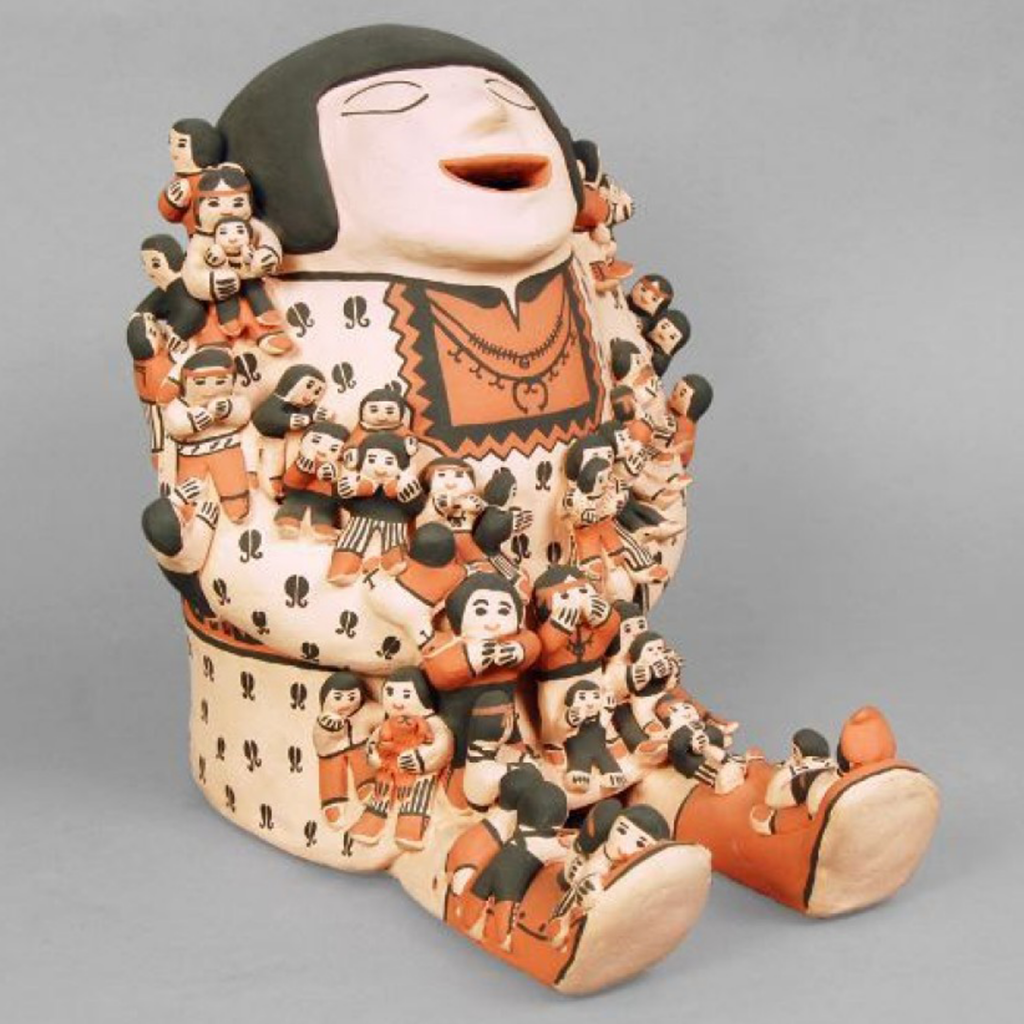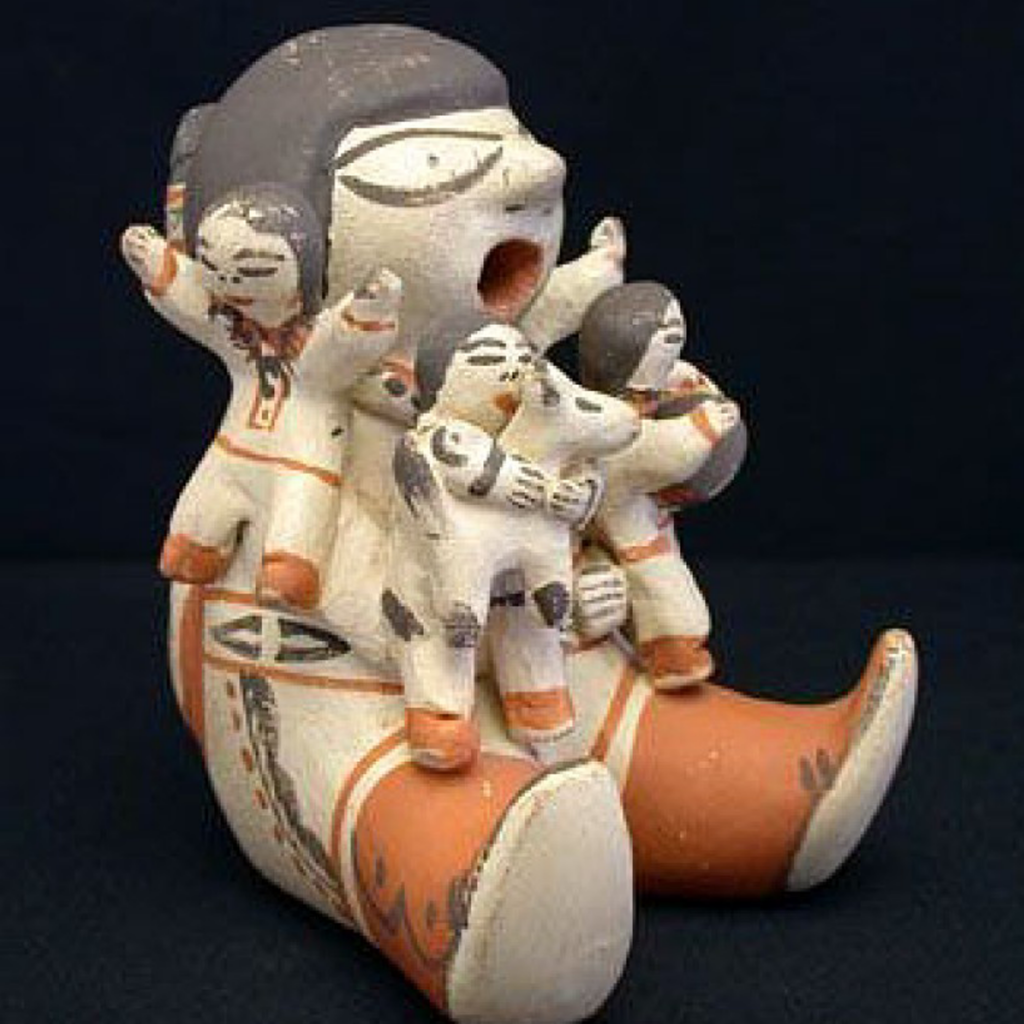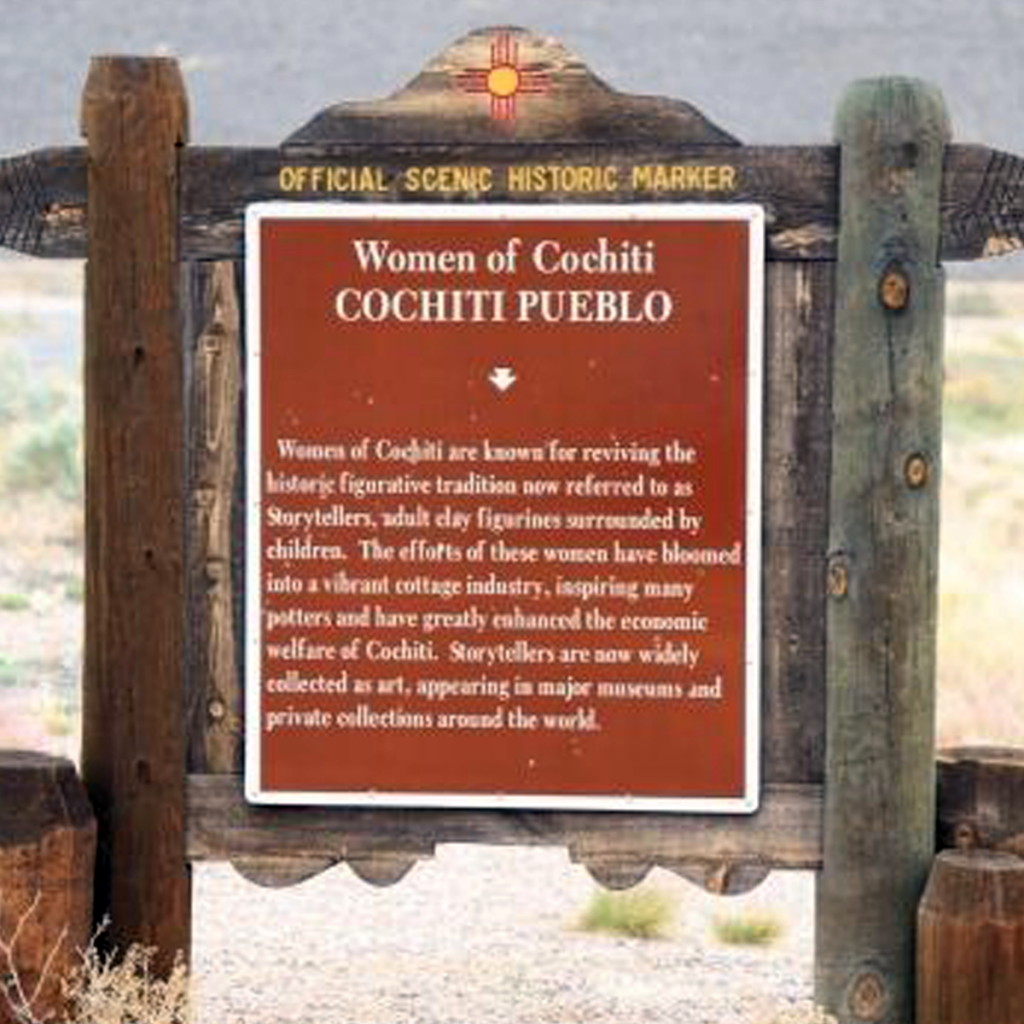Women of Cochiti “storyteller” figure.
Women of Cochiti
Storytellers–seated human figures with mouths wide open to represent oral storytelling–have flourished into a cottage industry in Cochiti, New Mexico. Women have played a central role in keeping figurative ceramics alive and innovating the craft to meet changing demands and interests.
By the late twentieth century, Pueblo figurative sculpture began to be valued as art, partly due to the popularity of storytellers, seated human figures with mouths wide open to represent the tradition of oral storytelling. Storytellers are now widely collected, appearing in major museums and private collections throughout the world. Moreover, storytellers reflect values that continue to characterize Pueblo society, including the importance of oral tradition, generational ties, and community.
Figurative ceramics—animal, bird, and human figurines—have historically thrived at Cochiti. As the tourism market grew with the coming of the railroad in the 1880s, Cochiti women crafted and sold human and animal figures to outsiders. During this time period, collectors and dealers referred to these figures by the Spanish word mono (monkey, silly fool, mere doll) and did not regard them highly. Many of these figures caricatured outsiders; scholars have speculated on their role as a form of social commentary on the changing demographics of late-nineteenth and early-twentieth century New Mexico. Use of the term mono to refer to all types of figures continued until the late 1960s, and thereafter the term storyteller came into widespread use. Storyteller is now used in much the same way that the term mono was used to refer to freestanding pottery figures in general.
Between 1920 and 1960, figures of women holding one or two children were the most popular at Cochiti. Scholars refer to these figures as Singing Mothers or Madonnas and recognize them as the precursor to the storyteller. Widespread acceptance of Pueblo figurative sculpture as an art form did not occur until the emergence of the storyteller in the 1960s. Scholars credit one Cochiti woman, Helen Cordero, with creating the Storyteller and sparking a revival in figurative ceramics. Like many other Cochiti women, Cordero had been making freestanding female figurines with one or two children. In 1964, at the request of folk art collector Alexander Girard, she made her figures larger and added more children. She crafted a male figure surrounded by children, a figure inspired by her grandfather. With open mouths and closed eyes, Cordero’s Storytellers appear to be in deep thought as they tell stories to surrounding children. Cordero noted that a Storyteller is strictly a male figure. Other Cochiti potters also began making their figures larger and with more children, often featuring a female or an animal figure as the focal point.
Traditional Cochiti storytellers have black and terracotta designs on a cream-colored background, a style that has characterized Cochiti pottery for more than a century. Some potters continue to use traditional natural vegetal and mineral pigments that artists like Cordero used, while others now use acrylic paints.
Cordero, as well as other notable Cochiti women potters, reinvigorated and helped turn this type of sculpture into a respected art form. In 1973, an exhibit at the Museum of International Folk Art in Santa Fe featured the storytellers of seven Cochiti women: Juanita Arquero, Damacia Cordero, Helen Cordero, Seferina Ortiz, Felipa Trujillo, Aurelia Suina, and Francis Suina. Storytellers have been adopted by potters in Pueblo communities throughout the Southwest, demonstrating the diverse forms, styles, and materials that are specific to each community. By the mid-1980s more than 175 potters throughout New Mexico Pueblos were making storytellers.
Sources:
Babcock, Barbara A. “At Home, No Womens are Storytellers: Potteries, Stories, and Politics in Cochiti Pueblo.” Journal of the Southwest 30, 1988, pp. 356–389.
Babcock, Barbara A., Guy Monthan, and Doris Monthan. The Pueblo Storyteller: Development of a Figurative Ceramic Tradition. Tucson:University of Arizona Press, 1986.
Falkenstien-Doyle, Cheri, “Cochiti Ceramic Figurines, 1880–1951,” American Indian Art Magazine 24, Fall 1999, pp. 38–47.
Lange, Patricia Fogelman. Pueblo Pottery Figurines: The Expression of Cultural Perceptions in Clay. Albuquerque:University of New Mexico Press, 2002.
Peterson, Susan. Pottery by American Indian Women: The Legacy of Generations. New York:Abbeville Press, 1997.
Directions:
Women of Cochiti
Sandoval County
Artist | Community leader | Cultural preservationist |
Mexican Period (1821 - 1848) | Pre-Colonial | Spanish Colonial (1540 - 1821) | Statehood (1912 - present) | Territorial Period (1848 - 1912) |
Central









